Dwight Eisenhower Worksheets
Do you want to save dozens of hours in time? Get your evenings and weekends back? Be able to teach about Dwight Eisenhower to your students?
Our worksheet bundle includes a fact file and printable worksheets and student activities. Perfect for both the classroom and homeschooling!
Resource Examples
Click any of the example images below to view a larger version.
Fact File
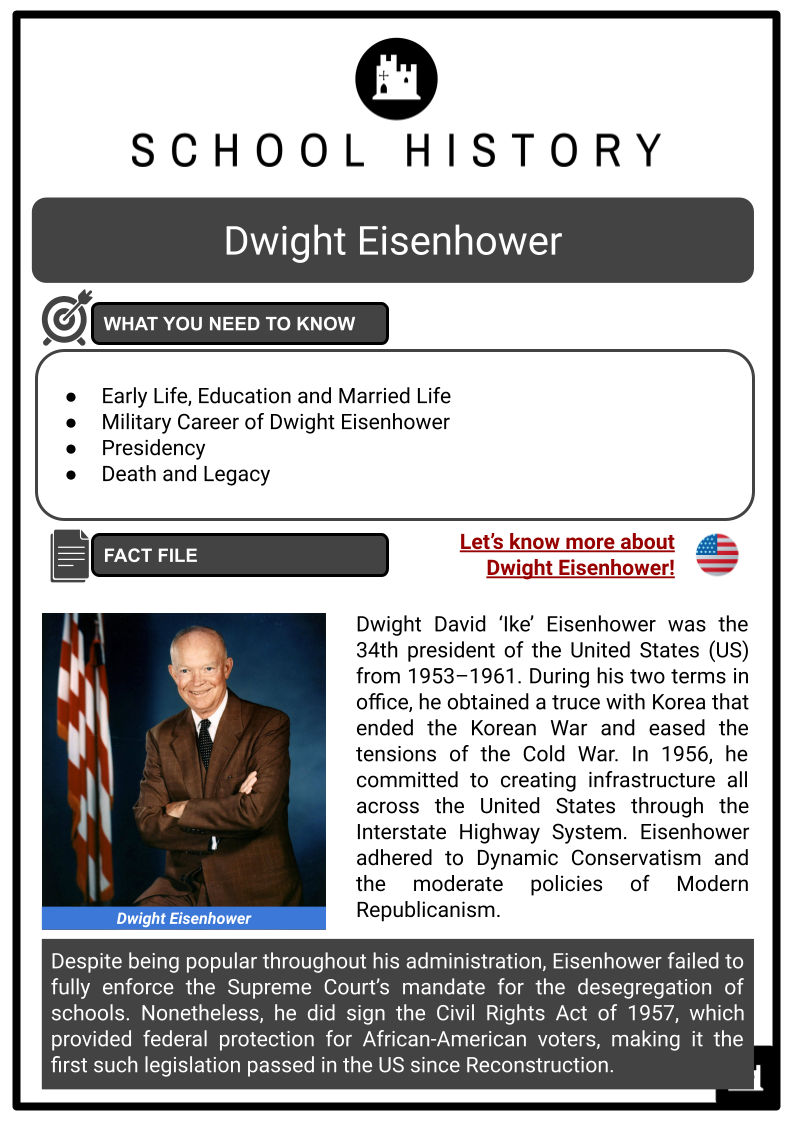
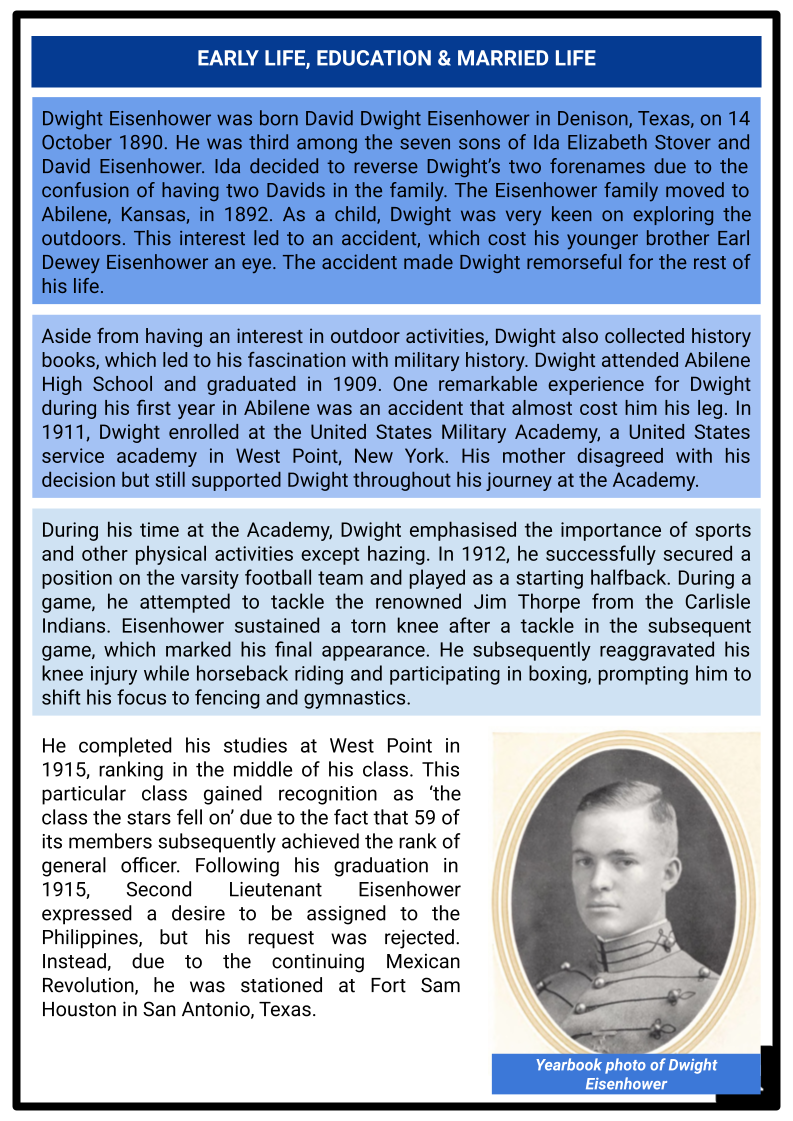
Student Activities
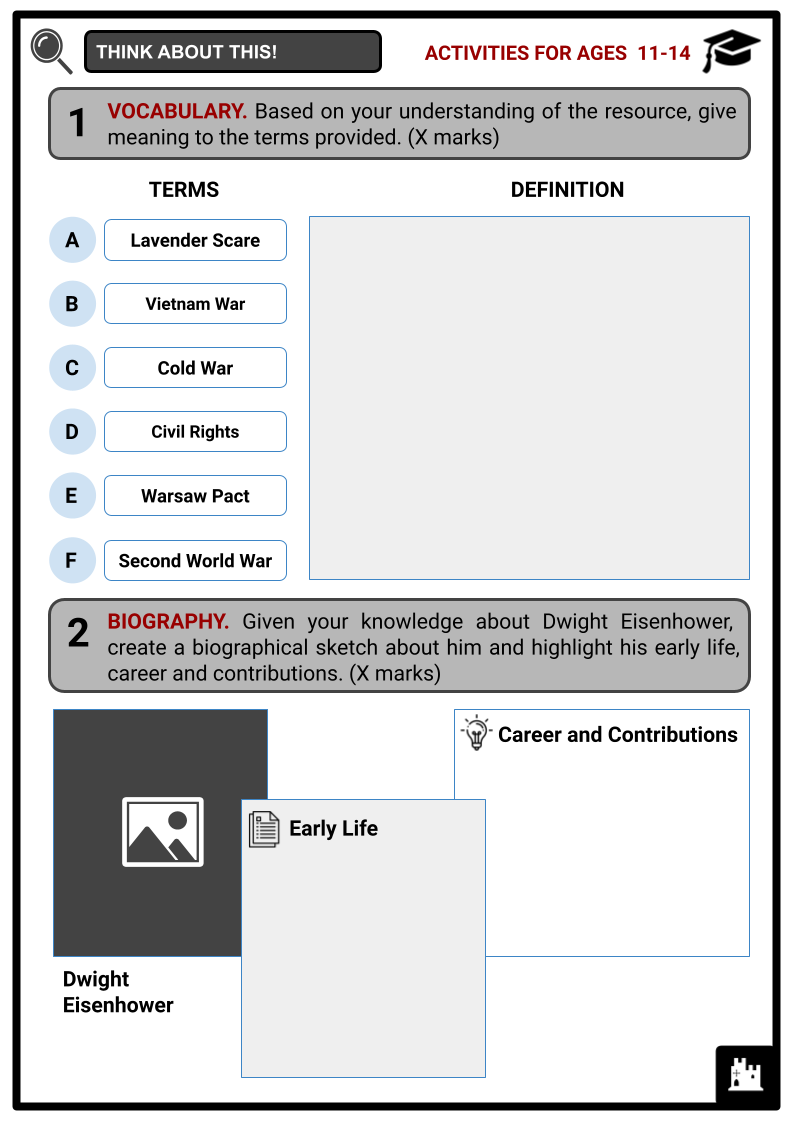
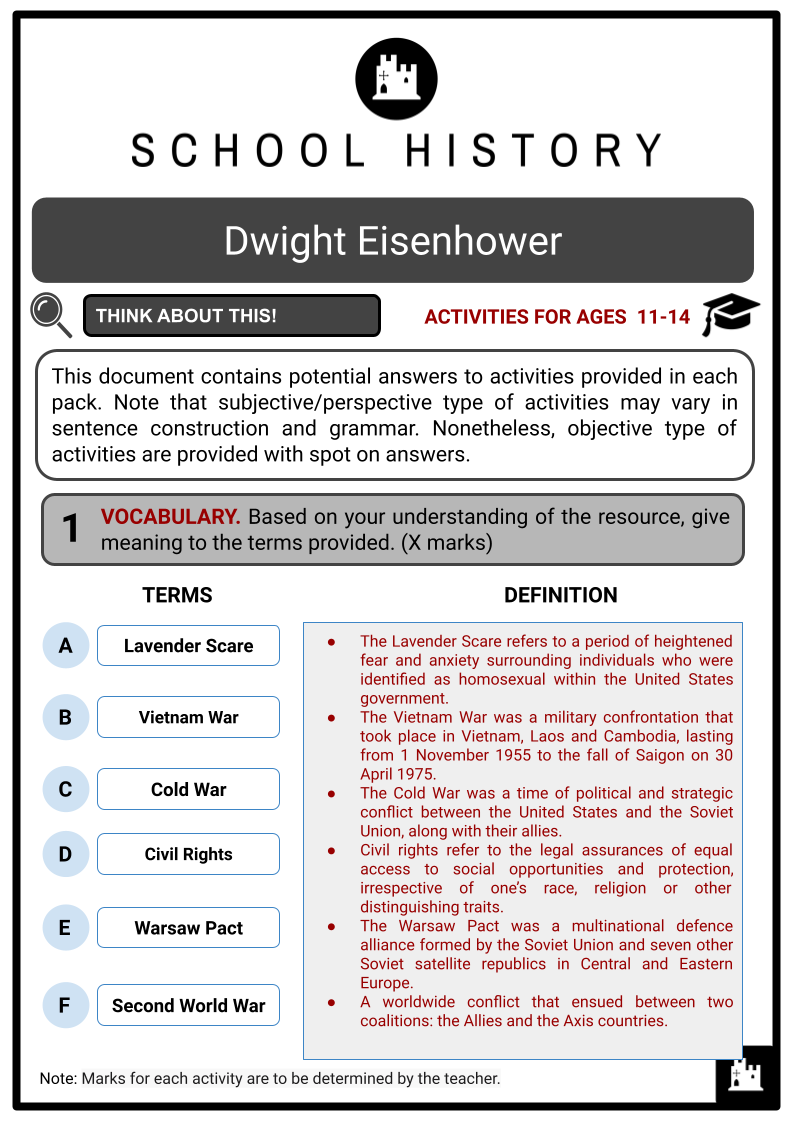
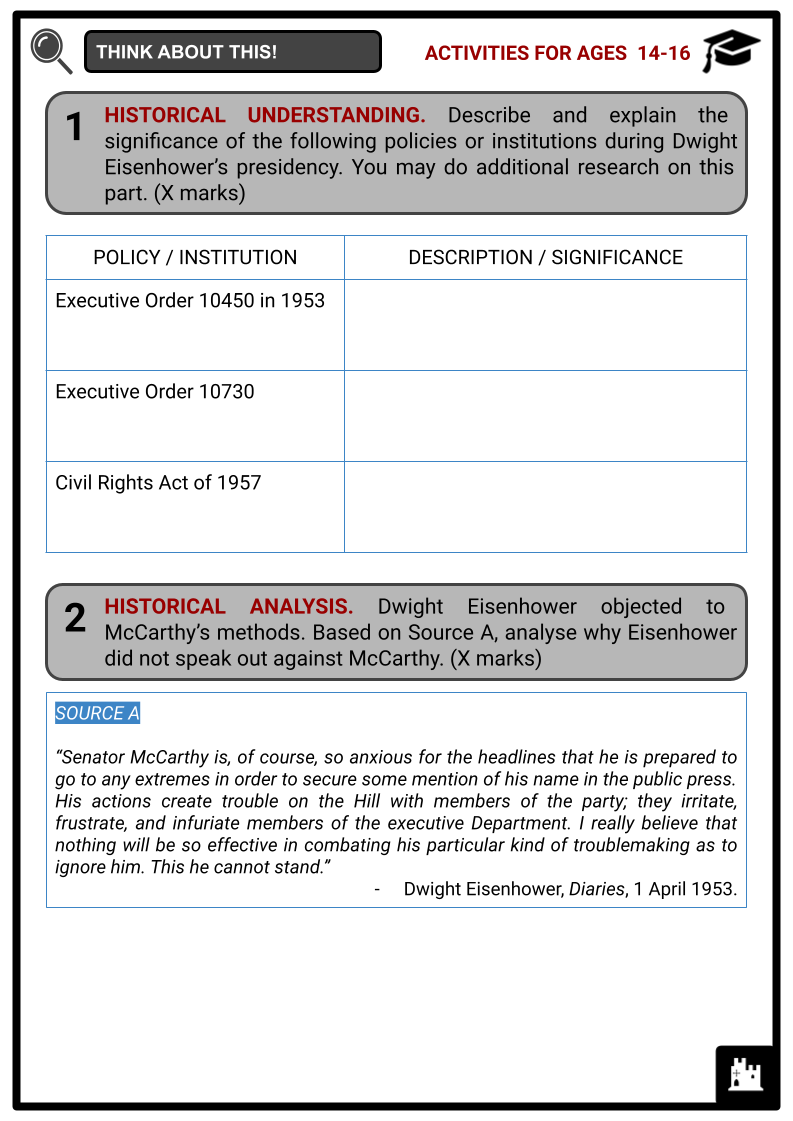
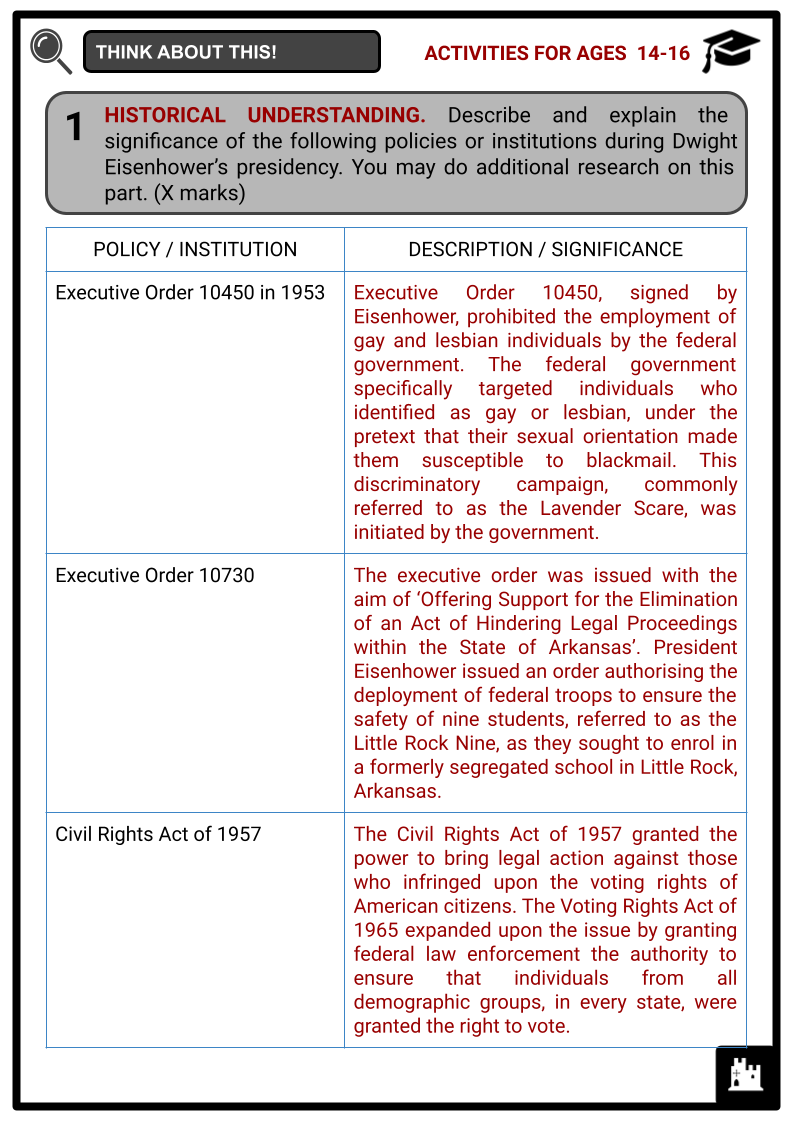
Summary
- Early Life, Education and Married Life
- Military Career of Dwight Eisenhower
- Presidency
- Death and Legacy
Key Facts And Information
Let’s know more about Dwight Eisenhower!
Dwight David ‘Ike’ Eisenhower was the 34th president of the United States (US) from 1953–1961. During his two terms in office, he obtained a truce with Korea that ended the Korean War and eased the tensions of the Cold War. In 1956, he committed to creating infrastructure all across the United States through the Interstate Highway System. Eisenhower adhered to Dynamic Conservatism and the moderate policies of Modern Republicanism.
Despite being popular throughout his administration, Eisenhower failed to fully enforce the Supreme Court’s mandate for the desegregation of schools. Nonetheless, he did sign the Civil Rights Act of 1957, which provided federal protection for African-American voters, making it the first such legislation passed in the US since Reconstruction.
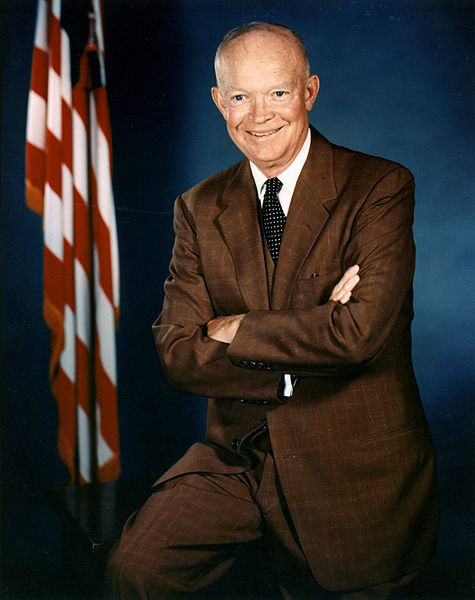
EARLY LIFE, EDUCATION & MARRIED LIFE
- Dwight Eisenhower was born David Dwight Eisenhower in Denison, Texas, on 14 October 1890. He was third among the seven sons of Ida Elizabeth Stover and David Eisenhower. Ida decided to reverse Dwight’s two forenames due to the confusion of having two Davids in the family. The Eisenhower family moved to Abilene, Kansas, in 1892. As a child, Dwight was very keen on exploring the outdoors. This interest led to an accident, which cost his younger brother Earl Dewey Eisenhower an eye. The accident made Dwight remorseful for the rest of his life.
- Aside from having an interest in outdoor activities, Dwight also collected history books, which led to his fascination with military history. Dwight attended Abilene High School and graduated in 1909. One remarkable experience for Dwight during his first year in Abilene was an accident that almost cost him his leg.
- In 1911, Dwight enrolled at the United States Military Academy, a United States service academy in West Point, New York. His mother disagreed with his decision but still supported Dwight throughout his journey at the Academy.
- During his time at the Academy, Dwight emphasised the importance of sports and other physical activities except hazing. In 1912, he successfully secured a position on the varsity football team and played as a starting halfback. During a game, he attempted to tackle the renowned Jim Thorpe from the Carlisle Indians. Eisenhower sustained a torn knee after a tackle in the subsequent game, which marked his final appearance. He subsequently reaggravated his knee injury while horseback riding and participating in boxing, prompting him to shift his focus to fencing and gymnastics.
- He completed his studies at West Point in 1915, ranking in the middle of his class. This particular class gained recognition as ‘the class the stars fell on’ due to the fact that 59 of its members subsequently achieved the rank of general officer. Following his graduation in 1915, Second Lieutenant Eisenhower expressed a desire to be assigned to the Philippines, but his request was rejected. Instead, due to the continuing Mexican Revolution, he was stationed at Fort Sam Houston in San Antonio, Texas.
- In early 1916, Mamie Doud and Eisenhower met. The two fell in love with one another and a few months after decided to get married. The couple had two sons: Doud Dwight ‘Icky’ Eisenhower, whom at the age of three died of scarlet fever, and John Eisenhower. Aside from being a member of the military, Eisenhower grew his interest in painting. His images were mostly landscapes and his subjects were family members.
MILITARY CAREER OF DWIGHT EISENHOWER
- During the First World War, Eisenhower remained stationed in the continental United States and ultimately became the leader of a battalion responsible for training tank crews. Following the war, he participated in a Transcontinental Motor Convoy that traversed the whole United States. In 1922, he was relocated to the Panama Canal Zone, where he worked under the command of General Fox Conner. Subsequently, he held a position on the American Battle Monuments Commission under the leadership of General John J. Pershing.
- In 1935, Eisenhower joined General Douglas MacArthur in the Philippines as a military adviser with the task of establishing and enhancing the Philippine Army.
- In 1939, Eisenhower came back to the United States and participated in the Louisiana Manoeuvres in the role of chief of staff under General Walter Krueger.
- Eisenhower assumed command of American forces stationed in Britain and was tasked with overseeing Operation Torch, the Allied military campaign to invade French North Africa in 1942.
- Following the triumph of Operation Torch, Eisenhower spearheaded the triumphant Allied incursion into Tunisia, compelling the capitulation of all Axis forces in May 1943.
- Dwight D. Eisenhower was designated as the Supreme Allied Commander of the Allied Expeditionary Force in the Second World War. As the commander-in-chief of all Allied forces in Europe, he spearheaded Operation Overlord, the amphibious assault on Normandy that involved crossing the English Channel in 1944. Eisenhower’s conviction that the invasion of Normandy would swiftly conclude the war is evident in his order of the day, a printed statement distributed to the 175,000-strong expeditionary force on the eve of the invasion.
- Eisenhower accepted Germany’s surrender in 1945, after the Allies won the fight.
- After his military career, Eisenhower became the President of Columbia University in 1948.
- He returned to the military office in 1951 as the first supreme commander of NATO, but left again in 1952 to run for the presidency.
PRESIDENCY
- In response to the candidature of Senator Robert A. Taft, a faction within the Republican Party known as the Draft Eisenhower movement convinced Eisenhower to announce his own candidature for the 1952 presidential election. Eisenhower’s decision to run for president was not taken lightly. It required a persuasive argument to convince him that the prevailing political conditions necessitated his candidature and that the public had expressed a clear desire for him to be their leader. Henry Cabot Lodge Jr. and others were successful in persuading him, and as a result, he stepped down from his position at NATO in June 1952 in order to focus entirely on his campaign.
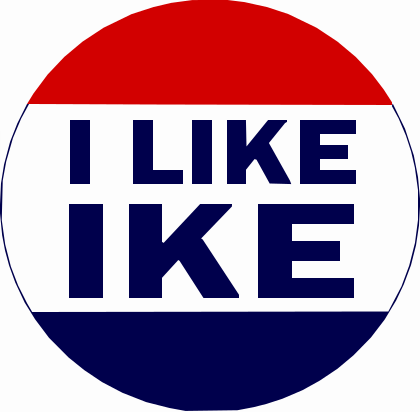
- Eisenhower was victorious against Taft in the nomination race, securing crucial delegate votes from Texas. To get the nomination, Eisenhower had to satisfy the conservative faction of the Republican Party known as the Old Guard. As a strategic move, he chose Richard Nixon as his running mate to pacify this group. Nixon also possessed a robust anti-communist reputation, in addition to being younger than Eisenhower, which served as a counterbalance to Eisenhower’s older age.
- Harry Truman and Eisenhower had minimal discussions regarding the transition of their administrations. This was due to a complete estrangement between them as a result of campaigning.
- Prior to his inauguration, he led a meeting of advisers at Pearl Harbor to address these foremost issues: balance the budget during his term, end price and wage controls, defend vital interests at a lower cost through a nuclear deterrent, and bring the Korean War to an end. In late 1952, he conducted the first pre-inaugural cabinet meeting in history where he articulated his anti-communist Russia policy.
- During his term, he made great use of press conferences, holding almost 200 of them. On 19 January 1955, he became the first president to conduct a televised news conference. Eisenhower, throughout his presidency, adhered to Dynamic Conservatism. His political and economic philosophy favoured a continuation of the New Deal and Fair Deal programmes with budget cutting as a high priority. As a progressive conservative, he described himself as ‘conservative when it comes to money, liberal when it comes to human beings’. In addition to continuing the programmes of his predecessors, he also increased the minimum wage, strengthened the social security programme and created the Department of Health, Education, and Welfare.
- After the war, consumer values dominated American society, especially the economy. By the 1950s, Americans were eager to spend on scarce goods after being hamstrung by the Great Depression and the Second World War. Consumerism refers to a social and economic belief that personal well-being depends on the extent of personal consumption or purchase of material goods. A consumerist society views life as better when there is more consumption of goods.
AMERICAN CONSUMERISM & ITS CAUSES
-
- Rise in consumer goods, including televisions and cars.
- Introduction of hire-purchase and easy consumer credit.
- Population growth meant greater demand for goods.
- Boost to industries including steel, coal and ammunition due to the Cold War.
- Rise in the American standard of living and consumer spending.
- Better working practices and mass production.
- Those who supported the consumption of local goods were regarded as patriotic.
- The desire for new items, including the television, radio, vacuum cleaner, car and washing machine.
- Growth in the suburban population.
- Introduction of mass production and assembly line.
- After the Second World War, many middle-class families and war veterans moved from the cities to the suburbs. Suburbanisation made affordable housing accessible and increased consumer spending and easy ownership of cars and other must-have household appliances. As the suburban population grew, businesses also became mobile. Shopping centres were built in new areas away from those in the cities.
- New motorways were built under the Interstate Highway System in 1956 under President Eisenhower for better access to shops and the suburbs. This enabled the building of motorways in accordance with the national plan, which fuelled the construction and automobile industries, motels, and petrol stations. Moreover, television and widespread advertising played a key role in fuelling consumerism in the United States.
USA AND THE COLD WAR
- During the election campaign, Eisenhower promised the Korean War would end and that he would go to the country to witness it personally. For two years, negotiations ensued, and by 27 July 1953, an armistice was signed in Panmunjom. The Prisoners of War (POWs) could remain where they wanted, and a new boundary near the 38th parallel was drawn, giving South Korea an additional 1,500 square miles of territory. Furthermore, a 2.5-mile-wide ‘demilitarised zone’ was established.
- The Korean War served as a proxy war between the United States and the Soviet Union. Proxy wars became a significant aspect, adding to the tension between the East and the West as the Vietnam War later followed the Korean War. In 1955, when West Germany was added as a NATO member, it allowed for remilitarisation, which was viewed as a threat by the Soviets. The Soviet Union and its satellite governments established the Warsaw Pact, a military alliance formally referred to as the Treaty of Friendship, Cooperation, and Mutual Assistance.
- The Warsaw Pact was directly governed by Moscow, which sought to exercise tighter control over satellite states. Its primary focus was establishing a coordinated defence among its members and enhancing its military capability to deter any internal and external attacks. The Warsaw Pact addressed revolts in Hungary and Czechoslovakia with force in 1956 and 1968, respectively. Despite growing tensions between the two organisations (NATO and Warsaw Pact), there was never a physical confrontation between them. Instead, both expanded the military forces of the US and the USSR.
- In June 1956, inspired by the events in Poland, the people of Hungary began a protest against the regime of dictator Matyas Rakosi. Like Stalin, Rakosi was known for imprisoning his rivals. However, with the new Kremlin government, Rakosi was highly opposed. In response, Moscow placed Erno Gero as the new prime minister, but many communists believed that Imre Nagy was more suitable. On 23 October 1956, a mass demonstration of students, workers and members of the Hungarian army gathered on the streets of Budapest. As riots proliferated, the Soviets agreed to establish a new government under the leadership of popular communist leader Nagy. By 28 October, Soviet militia began to withdraw tanks from Hungary.
- Imre Nagy was Hungary’s prime minister between 1953 and 1955 and was installed again during the 1956 revolution. He became known as a liberal communist leader who proposed several reforms. By contrast, the Soviets disliked Nagy’s reforms, especially leaving the Warsaw bloc as it would weaken the Soviet bloc. As a result, Nikita Khrushchev initiated a crackdown on the new Hungarian government to ensure Soviet security. On 4 November 1956, thousands of tanks crossed the Hungarian border. The revolution killed about 30,000 people. By 1958, Nagy was tried and executed after seeking refuge in the Yugoslav Embassy. Janos Kadar was placed in office to replace Nagy.
- Though expressing sympathy for Hungary, the US and the rest of Western Europe did not intervene in the conflict. Statements by the president and the American secretary of state were words without action. President Eisenhower was then busy campaigning for re-election. Like the United States’ primary concern at the time, Western European countries were paying much attention to the Anglo-French invasion of Egypt that sparked the Suez Crisis.
VIETNAM WAR
- Vietnam had been a colony of France prior to Japanese occupation during the Second World War. When the Japanese surrendered, the French returned to Vietnam. The returning colonial power was met with resistance as the Indochinese Communist Party, the head of a multiparty nationalist alliance called the Vietminh, led by Ho Chi Minh, seized power in northern and central Vietnam.
- After failed negotiations between France and the Vietminh, a war broke out. Communist China supported the Vietminh forces by providing military assistance. On 13 March 1954, Vietminh forces besieged Dien Bien Phu, a French military outpost near the border of Laos. The battle lasted for 57 days and ended on 7 May 1954. As France continued to suffer from significant casualties, they decided to hold peace talks with Vietminh forces. When France was defeated in Dien Bien Phu, they agreed to a settlement with Vietminh forces. Both parties held peace talks in Geneva, Switzerland, in May 1954. When Ngo Dinh Diem became the leader of South Vietnam, the United States provided aid to his non-communist government.
- Eisenhower was concerned that if South Vietnam fell into the hands of the communist North, other nations in Southeast Asia and the Pacific would follow. Firmly believing in the ‘domino theory’, the Southeast Asia Treaty Organization (SEATO) was formed in 1955, and aimed to combat communism in the region. Furthermore, 700 military personnel were sent to South Vietnam to provide military and economic aid to the government. The domino theory was a United States theory that suggested that if one country became communist, its neighbours would fall like rows of dominoes.
CAMPAIGNS FOR CIVIL RIGHTS
- In 1954, the first significant victory of the Civil Rights Movement happened with Brown v. Board of Education of Topeka, Kansas. An African-American family – the Brown family – filed a lawsuit in 1951 against their public school district when their daughter was refused enrolment to the school nearest their home and required to attend a school exclusive to African-Americans. Segregation of schools was ruled legal by the US Supreme Court during the Plessy v. Ferguson case in 1896. Therefore, schools for whites (Americans) were different from schools for Black people (African-Americans). Racial segregation in schools also meant differences in school facilities and curriculum, as supported by the Jim Crow laws.
- The Supreme Court ultimately ruled in favour of the Brown family, with all its members unanimously declaring the action taken by the school district unconstitutional. Not only was this a big win for the Civil Rights Movement, but it also led to the integration of schools in the South. By 1956, Senator Harry F. Byrd, Sr. of Virginia declared a massive resistance following the Brown v. Board of Education ruling.
- Within a year, state and federal courts declared these policies unconstitutional, and eventually, the resistance was overthrown. After the historic success of the Brown v. Board of Education of Topeka case, racial segregation in schools was deemed unconstitutional. However, in Little Rock Central High School in Arkansas, Governor Orval Faubus ordered the Arkansas National Guard to block the nine African-American students from entering the school on 4 September 1957 – the first day of classes.
- Members of the Little Rock Nine experienced harassment and abuse inside the school. Melba Pattillo was kicked and beaten. Gloria Ray was pushed down the stairs. In addition, an African-American effigy was burnt on the school grounds. Moreover, the Little Rock Nine were banned from joining extracurricular activities. At first, Eisenhower was reluctant to use his presidential authority to back up the enforcement of the Court’s verdict on Brown v. Board of Education as he believed that desegregation should proceed slowly. Nonetheless, he did send federal troops to Little Rock, Arkansas, to enforce school integration there.
- He intervened by issuing Executive Order 10730, which mandated that National Guardsmen should support the school integration by protecting the African-American students known as the Little Rock Nine. By September 1958, Governor Faubus ordered the closure of all high schools in Little Rock, which was supported by a public vote of 19,470 to 7,561 versus school integration. Some of the Little Rock Nine members finished their secondary education in other schools. Schools in Little Rock reopened in August 1959.
CIVIL RIGHTS ACT OF 1957
- The Civil Rights Act of 1957, as proposed by President Eisenhower in Congress, was enacted on 9 September 1957.
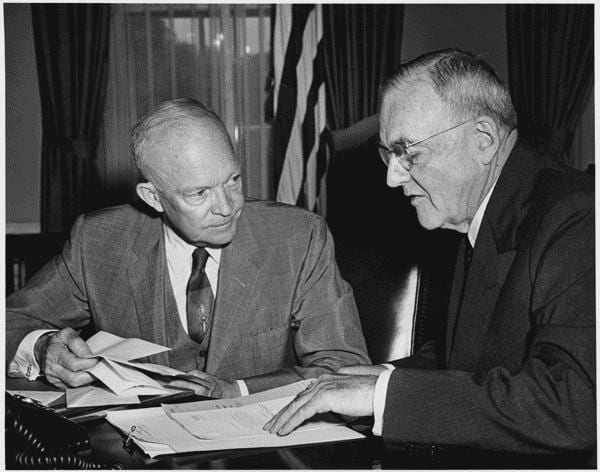
-
- It established the Civil Rights Section of the Justice Department.
- It strengthened the federal voting rights bill as per the Fifteenth Amendment of the US Constitution.
- It supported the national government for racial equality.
- It meant racial discrimination could be investigated through the formed Civil Rights Commission under the executive branch.
LAVENDER SCARE
- Eisenhower’s administration exacerbated the McCarthyist Lavender Scare by enacting Executive Order 10450 in 1953. The Order became a ‘witch hunt’ in the federal government. According to David K. Johnson, American author and historian, the Order prohibited thousands of lesbian and gay applicants from federal employment, and over five thousand federal employees were dismissed under the suspicion of being homosexual.
- Between 1947 and 1961, the frequency of dismissals due to sexual orientation exceeded those resulting from affiliation with the Communist Party. In 1973, a federal judge determined that an individual’s sexual orientation could not be the exclusive grounds for dismissal from federal employment. Subsequently, in 1975, the United States Civil Service Commission declared that they would evaluate applications from homosexuals and lesbians on an individual basis.
DEATH AND LEGACY
- After his presidency, Eisenhower relocated to a farm near the Gettysburg battlefield in Pennsylvania, where he and Mamie spent significant time after the Second World War. After leaving office, Eisenhower did not entirely stop from his political engagements. On 28 March 1969, he died from congestive heart failure at the age of 78. Eisenhower’s standing diminished in the early years following his departure from office. Throughout his tenure as president, detractors often perceived him as a passive, unstimulating leader who frequently engaged in golf. His successor, John F. Kennedy, who was 26 years younger, presented a strikingly different image.
- Although Eisenhower employed Army troops in an unprecedented manner to enforce a federal desegregation order at Central High School in Little Rock, he faced criticism for not fully endorsing the civil rights movement to the extent desired by demonstrators. Despite the prevailing strength of conservatism in politics throughout the 1950s, Eisenhower mainly focused on foreign issues and adopted a non-interventionist approach to domestic policy despite frequently expressing conservative views.
- Eisenhower was commemorated on the Eisenhower dollar, produced from 1971 to 1978. The Eisenhower commemorative dollar released in 1990 paid tribute to his centenary. The Dwight D. Eisenhower Memorial Commission was established by the United States Congress in 1999 to create a lasting national memorial in Washington, DC. In 2009, the commission selected architect Frank Gehry to create the memorial.
Frequently Asked Questions
- Who was Dwight Eisenhower
Dwight D. Eisenhower was the 34th President of the US, serving from 1953 to 1961. Before his presidency, he served as Supreme Commander of the Allied Expeditionary Force in Europe.
- What were Eisenhower's major accomplishments during World War II?
Eisenhower's major accomplishments during World War II include leading the successful invasion of Normandy (D-Day) in June 1944, a critical turning point in the war.
- What were some key policies of Eisenhower's presidency?
Eisenhower championed and signed the Federal-Aid Highway Act of 1956, creating a vast network of interstate highways. He also signed the Civil Rights Act of 1957, the first legislation of such kind since Reconstruction. He implemented the "Eisenhower Doctrine" to contain the spread of communism in the Middle East.
